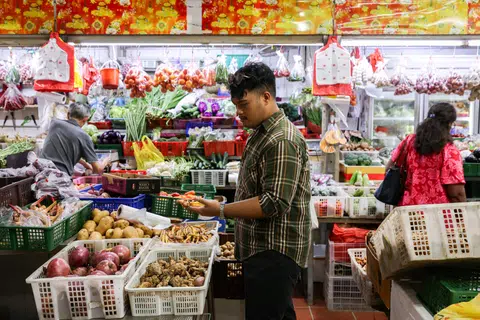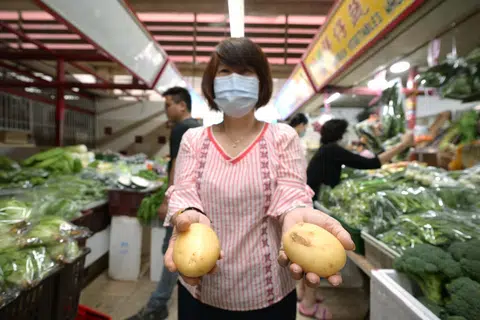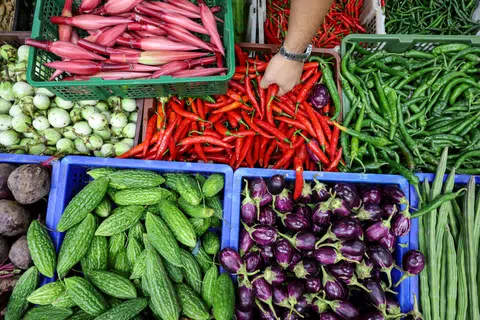7 wet market hacks you need to know
Forget the sterile aisles of supermarkets - dive into the vibrant world of Singapore's wet markets, where the freshest ingredients, best deals and unique shopping experiences await.
Here are seven insider tips on how to navigate the stalls.
1. Become a regular and reap the rewards
"Shop owners have so many customers, they can't possibly remember all of them. So stop market jumping, stick to the one that's closest to you, and go there on a frequent basis and chat up the owners," advises chef and cookbook author Pamelia Chia.
Vendors remember regulars and often offer special services to those who know how to ask for them. Ms Chia's aunt is so well known by the vendors at the market she frequents that some of them sometimes hand her items not available to other customers, like extra-fatty minced meat and out-of-season herbs, quietly slipping them into her trolley - almost like a covert exchange.
It takes time to build familiarity and trust with the vendors, so new shoppers need to be patient and keep going back, says 33-year-old Ms Chia.
"I learnt so much from the vendors and from the people who shop around me, and it makes the shopping experience a lot richer."
Chef and content creator Azfar Maswan, who visits the wet market at least once a week, agrees. Young people, he says, should not be intimidated by vendors who talk "roughly", or scold when they are asked too many questions.
"They are probably just busy and do not want customers lingering around their stall, so do not take it personally," says the 30-year-old.
2. The early bird gets the freshest ingredients
Vendors get their produce from wholesalers in the wee hours of the morning. Most wet markets open as early as 4am and start winding down by noon.
"You have to go early in the morning so that you get first dibs. Sometimes, after a certain time, like 11am or 12pm, you don't get the best ingredients," says Mr Azfar, who recommends that shoppers get to the market by 8am or 9am at the latest.

Unlike vegetables in supermarkets, which are refrigerated to keep produce fresh throughout the day, vegetables in wet markets tend to wilt much faster. If your leafy vegetables look a little wilted by the time you bring them home, a quick soak in ice should perk them up, says Mr Azfar.
If you are a late riser, do not despair. Some vendors slash prices or offer bundles at closing time to clear their stock. At 11am in Redhill Market, vegetable sellers display $1 bundles of assorted leafy greens, and even throw in free sprigs of scallions.
3. Buy only what you need
Madam Teo Siew Kwee, 69, works full time as a tea lady and cooks dinner for her family at least three or four times a week. She spends around $300 a month on groceries for her family of four by getting most of her fresh produce from the wet market.
Instead of pre-packaged supermarket portions, she buys exactly what she needs - whether it is a single piece of ginger for $1.50, or a precise amount of fish paste for homemade fish balls.
She says this helps her avoid food waste and save money.
Mr Azfar adds: "I think a lot of people are deterred from cooking because they have to buy a lot of ingredients, and then they go to waste when they are not used up."
So, if you need only a small quantity, head to the wet markets - no vendor will raise an eyebrow.
4. Engage your senses
One big plus of shopping at the wet market is that you can touch, smell and inspect produce before buying.
A good rule of thumb is to inspect vegetables and fruits for bruises and discolouration, advises Ms Chia.
Fruits like apples and pears should be firm to the touch, and fragrant when you sniff them.
For fresh fish, check under the gills, where the colour should be a bright red. Dark red gills indicate the fish has been dead for a long time. Clear eyes also show freshness, while cloudy eyes indicate an older catch.
Madam Teo offers tips for choosing some common ingredients: An eggplant should be slightly firm, but not hard. Shiny, smooth skin means it is fresh, while dull skin shows it was harvested a while ago.
Lotus root caked in mud "tastes better, sweeter and more tender", she says.
Choose skinny French beans because they are younger and more tender. The same goes for ladies' fingers: The smaller they are, the fewer seeds they have and the less fibrous they will be.
Go for green cucumbers with no yellow spots and that are not too fat. The bigger they are, the more seeds they have.

Content creator Sarah Huang Benjamin, 35, often asks the fruit seller in her neighbourhood market to help her pick the freshest and best-tasting fruits.
If you do not trust your own senses, a good fallback plan is to simply ask for help, she says.
"I don't know how to choose good cempedak - they all look and smell the same to me. I will ask the uncle to help me choose a few good ones," she says, adding that being polite and nice never hurts.
"If you are nice to them, they will always pick good stuff for you."
5. Embrace new ingredients
Wet markets have a wider variety of local produce that you may not find in regular supermarkets, such as Malabar spinach or moringa.
"The range of produce (at wet markets) is something that always excites me," says Ms Chia.
Different markets have their specialities. For instance, the Tekka market is known for ingredients used in Peranakan, Thai and Vietnamese cuisines. The Chinatown market is a great place to find dried goods, such as dried oysters and dried clams.
Geylang Serai wet market is a favourite haunt of Mr Azfar, especially when he is looking for ingredients for Malay and Indonesian dishes that are not commonly found in other wet markets.
At Geylang Serai, he has found yeast for making tempeh oncom, a Sundanese fermented tofu by-product, and even Chinese wine yeast, used as a starter to make rice wine. These are items he has never seen in supermarkets.
"In supermarkets, we find a lot of produce from very faraway places, sometimes unnecessarily far. I feel like wet markets are a lens into South-east Asian cuisine," says Mr Azfar. He experiments with new ingredients to whip up lesser-known regional dishes like Burmese tohu thoke (chickpea tofu salad) and Indonesian nasi ulam (steamed rice served with assorted herbs and vegetables).

It is also increasingly common to find trendy produce, popularly featured in Western dishes, in wet markets - often at much cheaper prices than at supermarkets.
"A lot of people have this misconception that wet markets only have local ingredients. When I went to Bukit Timah market, I saw broccolini," says Ms Huang Benjamin, who has also seen produce like kale, vine tomatoes and fresh borlotti beans.
"The funny thing is, I had just bought broccolini the day before at the supermarket for, I think, $4.95 a bundle. At the market, it was three bundles for $10!"
6. Corner stalls have lower prices
A money-saving hack that Mr Azfar has uncovered: Check out the stalls on the sides or those away from the main lanes. They tend to sell things cheaper than the stalls that receive the heaviest footfall.
"They sell the same ingredient, but sometimes at half the price (of more popular stalls)," he says.
Do not feel like you are obligated to buy an item after asking about its price. Take the time to visit other stalls to compare prices. Being firm and clear in communicating what you want will likely get you a better deal, says Mr Azfar.
7. Leave your designer gear at home
One of the tips Ms Chia gives in her book Wet Market To Table is for wet market shoppers to blend in with the crowd.
"Vendors sometimes size people up. If you're not from the neighbourhood, they'll look at the way that you dress, how you present yourself, and then they immediately assume they can charge a certain price," she says.
Ms Huang Benjamin has also heard of shoppers dressing down to avoid getting charged higher prices.
"If you really feel like you are being overcharged for an item, you can always negotiate. I feel like people are too shy to ask," she says.
There is really nothing to lose.
"If they say 'no', they say 'no' lor," she adds with a laugh.
Jessica Novia for The Straits Times